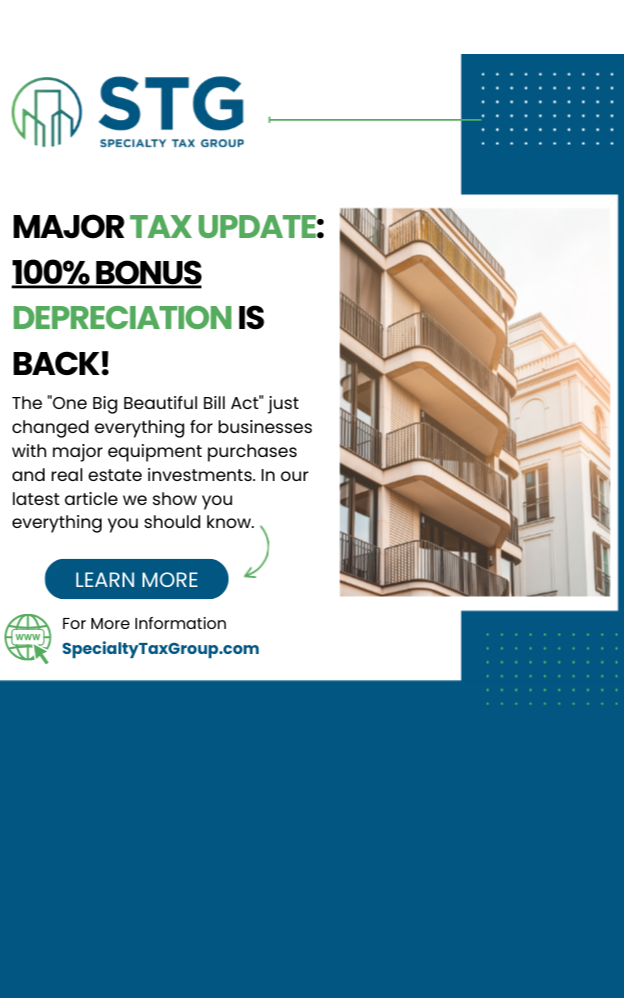This blog post has been researched, edited, and approved by John Hanning and Brian Wages. Join our newsletter below.
What Is Cost Segregation
Cost segregation allows us to identify components of a piece of real estate and depreciate those components faster than we normally would. A long term residential rental property depreciates over 27.5 years and a non residential property depreciates over 39 years. The land does not depreciate at all. The cost segregation study allows us to look into a real estate property and find items that we reclassify into short life assets.
Examples include a refrigerator, TV, linens, beds, kitchen supplies, pool tables, cabinetry, crown molding, ceiling fans, blinds, driveways, retaining walls, and swimming pools. These are personal property or land improvements that qualify for five year life property or fifteen year life depreciable property.
Once we identify these items, bonus depreciation allows us to write off anything with under a 20 year life immediately in year one on our federal income tax returns.
For more details, visit the
Cost Segregation Blogs Here.
How Bonus Depreciation Accelerates Cash Flow
Instead of writing off less than 3 percent in year one, cost segregation studies usually allow around 20 to 30 percent of the purchase price to be written off. Some factors allow as much as 50 percent of the purchase price to be written off in year one.
Driveways, swimming pools, cabinetry, carpets, office desks, TVs, linens, furniture, blinds, and other personal property can be written off immediately when identified in the study.
See real results from clients on our Cost Segregation Case Studies page.
When do we want to do a Cost Segregation Study?
The most common instances when we want to do a cost segregation study include:
1. Long term rentals with real estate professional tax status
This allows non passive losses that can offset W2 income or business income when the investor materially participates.
2. Short term rentals
If the average length of stay is less than 30 days and you materially participate, the losses can offset W2 income or business income. Short term rentals normally write off thirty percent because they come with beds, TVs, couches, and personal property.
3. Offsetting capital gain events
Losses from one rental property can offset the capital gain from selling another property.
4. Offsetting positive cash flow
A cost segregation study can create a loss that nets against the profits.
5. Business owners who own the real estate where they work
You do not need real estate professional tax status. The loss created offsets profits from the business.
To discuss the best timing for your property, reach out here:
Contact Specialty Tax Group
Frequently Asked Questions About Cost Segregation
How much can I save?
A single filer can offset up to $313,000 of income. Married filing joint can offset up to $626,000. Business owners can offset 100 percent of business profits.
Can I do a study after year one?
Absolutely. You can wait until the best year and take catch up depreciation.
Is cost segregation only for new properties?
Absolutely not. It does not have to be new construction and it does not have to be performed in the first year.
What if I sell the property after doing a study?
Depreciation recapture requires planning. Strategies include 1031 exchanges and creating losses to net against it.
What Types of Properties Qualify?
Any type of real estate with improvements qualifies. This includes:
- Multifamily
- Single family
- Self storage
- Restaurants
- Stadiums
- Stores
- Office buildings
- Warehouses
- Parking lots
The most important factor is whether the study will create enough tax deduction to justify the investment.
Explore examples here:
Cost Segregation Case Studies
Conclusion
Cost segregation is one of the most effective tax strategies for driving down taxes, accelerating depreciation, and increasing cash flow. The transcript illustrates how cost segregation studies have saved clients tens of millions of dollars, including a series of studies that saved one client about $4 million in taxes.
If you are ready to evaluate the opportunity for your property, schedule a consultation with
Specialty Tax Group:
Contact Us Here
2024 Tax Guide





